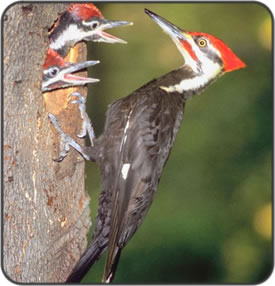

Information Related to "Pecking Holes in Evolution"
 | Audio/Video |
![]() Have
you ever walked through the woods and suddenly come across a woodpecker
busy at work? Its machine-gun pecks can be heard hundreds of yards away.
Have
you ever walked through the woods and suddenly come across a woodpecker
busy at work? Its machine-gun pecks can be heard hundreds of yards away.
 The pecking might seem quite useless, but through it the woodpecker
obtains food, builds nests, rids trees of insects, pounds out territorial
markings and gives warnings to other males as well as mating calls
to females. Truly it is one of the marvels of nature. But it is also
a real headache for evolutionists!
The pecking might seem quite useless, but through it the woodpecker
obtains food, builds nests, rids trees of insects, pounds out territorial
markings and gives warnings to other males as well as mating calls
to females. Truly it is one of the marvels of nature. But it is also
a real headache for evolutionists!
Even Charles Darwin, the father of evolution, marveled at the incredible features of this bird. He asked in his book The Origin of Species, "Can a more striking instance of adaptation be given than that of a woodpecker for climbing trees and seizing insects in the chinks of the bark?" (p. 166).
At least four uniquely developed features make the common woodpecker so unusual.
The first is its amazing tongue. It can be three times as long as its beak! Normally, a bird's tongue is about the length of its bill, but a woodpecker needs this extra long tongue to reach the grubs inside the trunk of a tree.
Where does it have the room to store such a long tongue? In some woodpeckers the tongue structure actually forks in the throat, goes below the base of the jaw, wraps behind and over the top of the skull and inserts into the bird's right nostril or around the eye socket. How did it manage to go almost 360 degrees around its skull and still manage to work?
Evolutionists have a hard time explaining this wondrous "adaptation." They claim the woodpecker must have evolved from other birds with normal tongues that go straight out of the beak. Yet the idea that this all happened through small, gradual steps stretches the imagination.
Not only is the length of the tongue a marvel, but also its texture. In young woodpeckers, the tongue is smooth, and it does not grow barbs that can catch larva until adulthood. So how do young woodpeckers catch their meals? They secrete a special saliva that acts like glue until they can eventually develop the barbs to hook the insects! So the woodpecker's tongue can create glue and later become a barb factory—all arriving at the right time so the bird can survive. Can evolution explain all of these characteristics?
A second amazing feature of woodpeckers is their beak. Imagine trying to drill into a hardy tree trunk. First you have to bore a hole through the tough bark and then into the hard wood. Yet the woodpecker can make it look easy because of its specialized bill.
The woodpecker's beak works like a chisel, capable of boring right into a tree. As it pecks, it finds the grubs inside the trunk through vibrations and the grub's noise. Then it makes just the right hole with the proper angle to reach the insect galleries with its long tongue. In this way, it does its job in nature—protecting trees from insect infestation.
With modern technology, we can use steel chisels to cut into trees like a woodpecker, but eventually the chisels lose their sharpness. Yet scientists have found that a woodpecker's bill stays sharp, no matter how many holes it drills into trees! So man's technology can't duplicate with the same effectiveness what the humble woodpecker can do.
A third feature is the woodpecker's special shock-absorbing head. If an ordinary bird tried to bore a hole in a tree trunk, the impact would soon kill it. It is like taking the full impact of a hammer hitting a chisel on the end of your nose thousands of times. The woodpecker, however, comes equipped with a shock-absorbing system that protects its head from damage. It is composed of a spongy tissue between the beak and the skull, thus absorbing the violent shock waves without affecting the bird's brain.
Finally, the woodpecker does not have ordinary tail feathers but specially designed ones to anchor it while going about its business. These stiff, spine-tipped pointed tail feathers are used as a brace while climbing a tree or feeding. They allow woodpeckers to lean back in order to literally throw their body into their work.
All four of these amazing features (and many others) would have to evolve at the same time to give survival benefits to a "proto-woodpecker." How could evolution and natural processes explain that?
Actually these are just a few of the marvelous features of the woodpecker that give strong evidence of its being the product of intelligent design rather than of evolution. As Psalm 14:1 says, "Only a fool would say, 'There is no God!'" (Contemporary English Version). VT
About the author:Related Information:
Table of Contents that includes "Pecking Holes in Evolution"
Other Articles by Mario Seiglie
Origin of article "Pecking Holes in Evolution"
Keywords: woodpecker evolution
Evolution and biology: